Handling actively degrading film – Tools and Products
by Morten Jacobsen
This article from Image Journal was based on a presentation given by Morten Jacobsen of Dancan International as a guest speaker at the EBU Training Seminar dealing with Film in Television Archives held in Sarajevo, on 14-15 April 2000
The ‘Vinegar Syndrome’
Film archives worldwide are suffering from the ‘Vinegar Syndrome’ and it is grimmer than anticipated. Its effects are worse than those of nitrate film decaying. It Is the ‘Silent Killer’. It is the disaster we need to combat in the third Millennium.
How did this happen?
Lack of knowledge? Lack of support from film manufacturers? Lack of research into the problems? Negligence in Storage? Negligence in following recommended standards? Negligence from politicians to preserve the heritage?
In the first half of the 20th Century we had nitrate film. Much of this went up in fire and exploded violently, but what is left is in pretty good condition. It has now happened a second time. And this time it stinks of salad dressing. It is ‘The Silent Killer’
also called the ‘Vinegar Syndrome’
How we can detect the ‘Vinegar Syndrome’?
Your very first reaction when you open a can is the smell, and the smell of vinegar is of course obvious. Even if You have caught a cold you can smell it, or can you?
In reality, the vinegar syndrome develops long before you can smell it. That is the danger. You simply have to test every single roll of film. If you have 20 rolls in the can, test them with AD-Strips (‘A-D’ stands for ‘acid detecting’) which are acid-base indicator papers which turn from blue to green and then to yellow in the presence of increasing amounts of acid. They measure film deterioration in an indirect manner by reacting to the amount of acidic vapor present in a confined air space above the film. The AD-Strip gives a reading in 24 hours. Danchek gives a reading in 2 hours.

Follow the instructions given by the manufacturers. If you have films you want to monitor more closely there is the Danchek Control Eye. As you can see in the picture below there are control eyes mounted in pre-punched holes in the cans. The top one is yellow and the bottom is blue. In this way you can take a walk in your vaults and spot the films that has been struck with the ‘vinegar syndrome’.
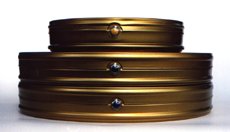
 Danchek Control Eye
Danchek Control Eye
Film handling
Here are some guidelines to handling the situation. Initially you should take care as you open the old cans and test each film with the acidity tester. Then put the film into new cans, divided into categories according to the reading of the acidity testers. This will create new problems, since your collection must then be put into different vaults according to level of acidity. This is in order to avoid infection of the not so acetic films.
Negatives come first
You must begin with the negatives. They are the most important assets in any archive. Some feature film copies could be re-ordered from the studio, but perhaps you are the archive that holds the one and only copy of a given title.
Get rid of magnetic tape on triacetate
16, 17.5 and 35mm perforated films on acetate based motion picture film are considered to be the biggest problem. They should be recorded onto polyester based tape and discarded.
Wind your film
Winding of film is a delicate problem. No existing hand winding method is capable of maintaining a constant tension throughout the length of a film. Tension should be in the order of 15-20 ounces and that can only be performed on special electronically controlled winders. Winding your Film means airing your film and that is good.
Buy a new core (bobbin)
A core is usually made of wood or polystyrene, or there may be none at all once you open your can. Polystyrene is one of a group of plastics which can ‘bleed’ over a long term, and nobody wants that in his archive. Manufacturers are now making cores in polypropylene and that is definitely a step forward.
Film cans
You now come to the crucial question of which film can to choose. Should it be another metal can where metal is still considered a catalyser for the ‘vinegar syndrome’ or should you use the coated ‘Kodak’ type metal tin? The coated tins are a step forward, but that has not been verified in scientific tests. If you store your films in paper, carton, corrugated carton or whatever, then you should test the carton for acidity with a pH meter. It will surprise you that the carton acts like a sponge and attracts acetic acid from the film. It has been verified by the Image Permanence Institute that molecular sieves or silica attract acetic acid and so does cardboard. IPI and the manufacturer of the molecular sieve (Kodak) recommend frequent change or when saturated.
Or, should you consider changing to plastic? There is a choice of plastics available, ranging from recycled polypropylene to ‘straight from the sack’ polypropylene. You can even choose a polypropylene with additives, such as a package of ‘antioxidants’, which protects the can from the free radicals, the peroxides and so forth.
https://www.dancan.dk/papers
Discard plastic bags
Thin polyethylene or polypropylene or pvc (poly-vinyl-chloride) plastic bags have been used for decades to wrap around the film when delivered from the laboratory. It is a habit that is difficult to get away from. First of all the quality of the bag is unknown (not stabilized) and it prevents the film from breathing. There are of course different opinions on the use of plastic bags. If an inferior film can is used, then the plastic bag can sometimes be an advantage, but if the film has the ‘vinegar syndrome’ then it should certainly not be packed tightly within a plastic bag.
Remove paper information from the can
It has been customary for decades to store film content information, printing information etc. in the can with the film. It is advisable not to do so because you don’t know the chemistry of paper.
Keep sound and picture separate
This is first of all a hint to TV Stations. It has always been good housekeeping to store picture and sound in the same can. It was practical because you always had 16mm picture and 16mm perforated soundtrack in the same can so whenever there was a need to put it on the scanner you could always find it. Whenever I say that to a TV Station they get frantic. It implicates physical separation and index separation. It has been proved that film stored together with sound deteriorates faster because the sound track acts as a catalyst for the ‘vinegar syndrome’. Sorry, I can’t help it, but that’ life.
Choice of can?
Metal tins? Plastic cans? Cardboard cartons – or no can at all?
What is IPI’s view?
The diagram below came from Jean-Louis Bigourdan of the Image Permanence Institute in Rochester (USA) who gave a presentation at the JTS2000 conference in Paris in January 2000. It is very interesting to note that a metal can without a lid renders the least acidity change and that is not a surprise. The cardboard box came next and that clearly confirms the theory of Manchester Metropolitan University who showed that the cardboard acts as an adsorber like a molecular sieve or silica sieve. In practice the box is never changed, whereas molecular sieves must be changed every 2 years or when saturated.
It is interesting that where MMU has tested under elevated temperature conditions (700C and 50% RH) using fresh film then IPI uses an approach where it pre-ages the film and then tests at room temperature.
The third best is the drilled (PP) polypropylene box. This proves my point that ventilation is important, and the more the better, but it does demand increased circulation of air in the vault.
The fourth and fifth best options are the sealed PP box and the sealed metal can. They are virtually identical and show the worst results.
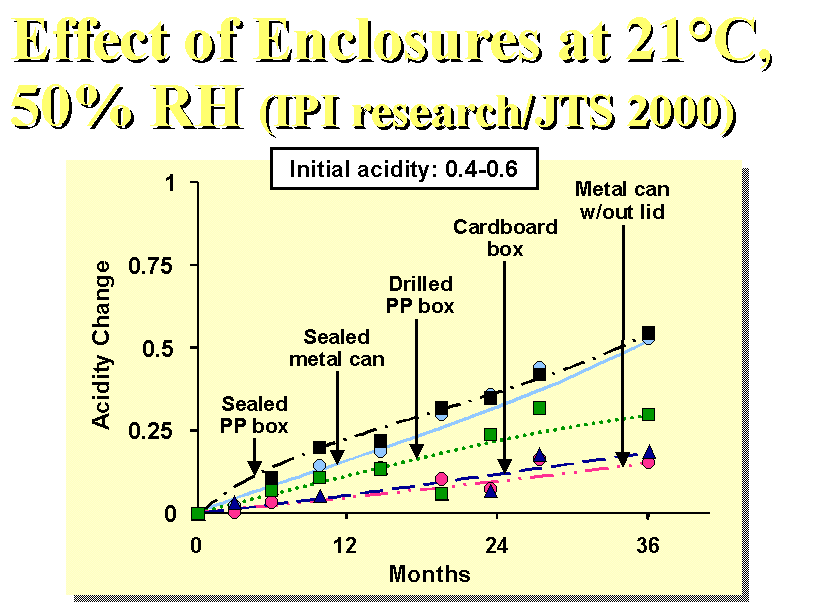
What is Manchester Metropolitan University’s point of view?
The degradation of cellulose acetate base motion picture film was the title of a thesis submitted in partial fulfillment of the requirements for the award of Doctor of Philosophy by Diana Michelle Williamson BSc (Hons) GRSC in 1994, of the Department of Chemistry at Manchester Metroplitan University, England. The following extracts are interesting.
The properties of cellulose acetate based motion picture film
The development of cellulose triacetate in the 1940’s for use as a flexible support in motion picture film was due to its excellent physical and chemical properties. Indeed the proper performance of the film projector and therefore screen quality depends to a large degree of the physical properties of the film. Early work into the stability of motion picture film was therefore aimed at the physical properties of the film including durability, tear strength and also thermal and chemical stability compared to that of the cellulose nitrate film. We will discuss the physical properties.
The dimensional stability of cellulose acetate based motion picture film
Any changes in the distance between perforations (perforation pitch) in motion picture film can directly effect any further play back or projection of the film. This lengthwise or widthwise shrinkage has been described as either being temporary or reversible, as the result of temperature and/or humidity changes or permanent changes which occur during ageing.
The effect of moisture upon dimensional stability
One of the most important physical properties of motion picture film is its ability to adsorb and lose moisture. This affects the physical characteristics in that the film can become brittle if too dry, or limp and tacky if too moist. The controlling factor in the loss or gain of moisture is determined by relative humidity. (%RH). This generally means that the base expands at higher humidity and contracts at lower humidities. It is known that gelatin emulsions adsorb approximately ten times the amount of water than triacetate base support. This means that at low relative humidities the emulsion layer has a greater tendency than the base to contract resulting in shrinkage of the motion picture film. In contrast, at high relative humidities the emulsion will swell resulting in an overall increase in the film dimensions.
The effect of storage containers on cellulose acetate based motion picture film
The effects of the different storage containers on % viscosity retention are illustrated in figures 7.32-7.36 (numbers from original thesis). It can be seen that with all the containers investigated there is a loss in the viscosity of the motion picture film in each case over the time period studied. Although ageing was undertaken at an elevated temperature, this was well below the glass transition of the cellulose acetate polymer and so the same relationship between the films at ambient conditions would be expected.
The first interesting point to note is that the viscosity retention of the motion picture film aged in the metal can has been maintained, relative to each of the alternative ‘plastic’ cans. In the case of cellulose acetate based motion picture film a 10% loss in viscosity is considered to indicate that the film has suffered an irrevocable loss in its physical properties.
I will take you through the graphs one by one. They are important for the understanding of degradation in different film cans.
Figure 7.32
Viscosity retention. It loses nearly 10% of the viscosity. HDPE is high density polyethylene. PP is copolymer polypropylene. Both types are commonly used in the plastic manufacturing industry. They are considered the most inert.
Figure 7.33
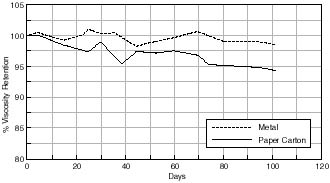
It is interesting to see that the carton loses even more than the unstabilized plastic can. IPI has as you have seen previously, rated cartons highly for their ability to adsorb acetic acid. That is of course true because it adsorbs like a molecular sieve or silica sieve. In the recommendations for the use of that kind of absorbers it is advised that the sieve or silica should be changed about every 2 years or when saturated. Who changes a film carton every 2 years? Try to measure the acidity of your cardboard or paper carton.
Figure 7.34

The Dancan was then manufactured with stabilizers. You don’t see them, you don’t feel them. They are part of the composition and added when the plastic is melted prior to injection into the mould. The stabilizers protect against the free radicals, ultra violet radiation and peroxided and this seems to be the proof.
Figure 7.35
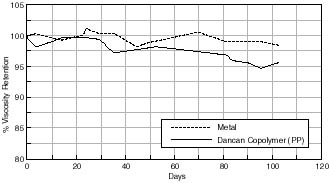
Dancan manufactured in unstabilized Copolymer PP shows the same characteristics as manufactured with HDPE. (High Density PolyEthylene). PP is todays chosen material because it is lighter, more flexible and has less tendency to warp.
Figure 7.36
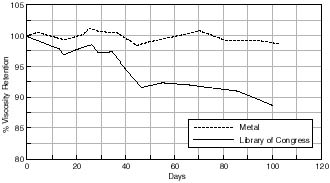
To complete the picture we show you a film can made by Plastic Reel Corporation in the USA. One possible explanation for the different effect of the polypropylene can compared to the other cans investigated involves looking at the effect of the other components of the can itself. The Library of Congress can contains the flame retardant ethylene bis (dibromoborane) dicarboximide (3-4%). It is possible that this component has had a detrimental effect on the % viscosity retention of the cellulose acetate based motion picture film.
We will now measure Change in Acidity of Cellulose Acetate Based Motion Picture Film with Time at 50%RH/700C.
Any changes in the acidity of the cellulose acetate based motion picture films when aged in contact with the various cans is shown in figures 7.41-7.45. The first point to note is that all the film acidity readings are comparable. However, a few features do come to light. Firstly the paper carton shows a better acidity trend compared to the metal can. This is due to the fact that the carton is adsorbing any acid being produced as the cellulose acetate based film is degrading. Secondly the unstabilized cans, namely the Library of Congress can and the unstabilized HDPE Dancan show a decrease in pH. From this it can be assumed that the growth of hydroperoxides in the can has then had a detrimental effect of the consequent film stability. In contrast the acidity of the film with the stabilized Dancan has remained unaffected.
Figure 7.41
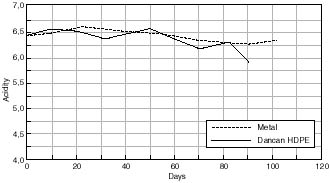
An unstabilized Dancan in HDPE.
Figure 7.42
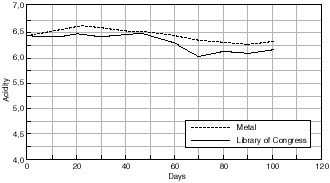
The film can from Plastic Reel Corporation manufactured for Library of Congress in the US.
Figure 7.43
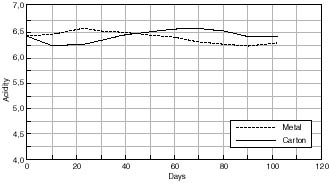
Clear evidence that the carton adsorbs vinegar from the film.
Figure 7.44

Coming back to discussions on stabilized plastic film cans. This is again clear evidence that the package of antioxidants have an effect. Whereas the cardboard adsorbed the vinegar, the stabilized Dancan does no harm to the film.
Figure 7.45
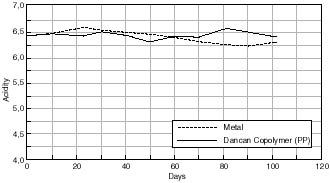
Even the unstabilized Dancan in Copolymer PP shows a very good result.
Figure7.39
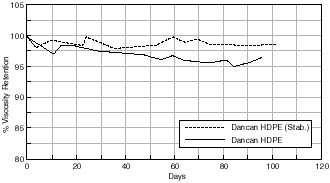
And very finally, a comparison between stabilized and unstabilized polyethylene. Can there be any doubt?
Is it really necessary to ventilate your film cans?
We have to look back at the graph from IPI. Open cans show the best result. Cans with drilled holes comes close to that.
I have done tests with 3 types of cans.
o Closed Dancan
o Dancan with lid lifted 1mm
o Dancan with 2 holes punched near the button
Tests were performed with a film at level 1 and a Dräger Tube Acidity Tester. The lowest reading obtained was 3. The reason is that the acetic acid fumes developed from the film are heavier than air and can therefore escape the can.
EBU Technical Recommendations R101-1999
Kjell Kolstadt from NRK in Oslo has rewritten the storage conditions for TV Stations
See: www.ebu.ch/texts.html
I will quote the introduction.
In the early days of television, a number of recommendations on storage conditions for film took into account broadcasters ‘need for immediate access to program material’. The conditions specified were termed ‘medium term’ storage conditions. These conditions and some have reported serious deterioration in their film collections. The most critical problem is the base deterioration called the ‘vinegar syndrome’. This degradation is today considered the major threat to life expectancy of acetate based films and especially the accompanying magnetic sound. Historical evidence of archiving and storing film suggests that doing nothing is not an option.
Storage conditions for acetate based motion picture film and accompanying magnetic sound material is +50C and 25-30% RH. (See table 1).
Conclusion
Mr. and Mrs. Archivist. You have to trust science because if we don’t use science for testing and predictions then you know nothing at all. Consider this a guideline and get started right away.
If you need further advice please do not hesitate to contact me. I can advise you on building cold storage archives and on everything to do with the archiving process.
Good Luck
Morten Jacobsen
Dancan International Sales
Box 308
1501 Copenhagen V
Denmark
Phone (+45) 40 50 41 80 – Fax (+45) 29 54 88 11
![]()
CV
Morten Jacobsen was born in 1938 in Copenhagen, Denmark. His interest in film started early, and in his teens he used 8mm, Super 8 and 16mm. In the swirl of his youth masters like Dreyer and Eisenstein made impressions and film clubs widened his horizons, leading to Youth Festivals in Berlin and a prize in 1962 , when the wall had just been built.
Then came a taste for the professional scene, at a time when a cameraman was often a guy picked from the street. Morten moved up to 35mm format and began to make short films.
New ventures came along, such as an encounter with products like brand new plastic film spools and cans from Australia. The Seventies were booming. Tooling for square film cans led to a range of 16mm Dancans.
In the Eighties, Morten developed an interest in 35mm and film archives and added more tools to his range. Then came the Nineties, the period where the “Vinegar Syndrome” became hot and Danchek was invented. Research projects in England and numerous papers presented in Europe and USA followed. To-day he is considered a specialist in film storage and is always willing to let others benefit from his experience.
